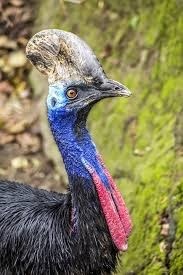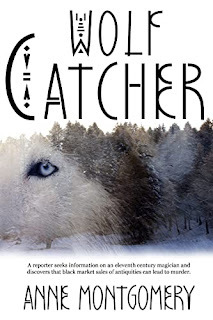The Cassowary: Why We Should Care
From Anne Montgomery
It’s estimated that nearly 500 animal species have become extinct sincethe beginning of the 20th century. Among them the Passenger Pigeon,Japanese Sea Lion, Western Black Rhinoceros, Golden Toad, Caribbean Monk Seal,and Mexican Grizzly Bear, now gone forever.
And yet, for most of us, the absence of these creatures makes no differencein our daily lives. Perhaps that’s why some people roll theireyes when they hear about saving the tiny Snail Darter or thePolar Bear or the Gray Wolf.
But what if a creature existed that could change lives with itspassing? And I mean change in a big way.
Meet the cassowary.

 I first became aware of the giant, Australian bird that vaguely resembles anostrich, but which sports a fabulously-colored keratin casque, whilewalking in the Daintree Rainforest – a UNESCO site like the GreatBarrier Reef over which it hovers – that has one of the most complex ecosystemson Earth, hosting species whose ancestors date back 110 million years.
I first became aware of the giant, Australian bird that vaguely resembles anostrich, but which sports a fabulously-colored keratin casque, whilewalking in the Daintree Rainforest – a UNESCO site like the GreatBarrier Reef over which it hovers – that has one of the most complex ecosystemson Earth, hosting species whose ancestors date back 110 million years.“The cassowary is extremely important,” our guide explained. “Withoutthe bird, the forest would not exist.”
Daintree is primordial. Giant strangler figs crawl across the forest floor.Dappled sunlight sneaks though a thick green canopy. Massive ferns sproutfrom leaf-littered soil. The outside world is muted, and the sight ofa dinosaur might not seem strange.
I learned the cassowary is a one-bird master gardener, a creaturethat combs the forest floor eating fallen fruits, even gobbling up plants thatare toxic to other creatures. The bird consumes up to 150 different types offruits. The existence of 70 to 100 plant species depends on thecassowary pooping out their seeds in a pile of protective,compost-like dung, the smell of which repels seed predators. The cassowary is a“keystone” species, which means a species on which others in an ecosystemlargely depend, one that, if removed, would cause the ecosystem to changedrastically.
So, no cassowary, no rainforest. But there’s more. Below Daintree aremangroves, a mucky area rich in bio-matter that filters down from the forest.All types of young creatures - crabs, jellyfish, snappers, jacks,red drums, sea trout, tarpon, sea bass, and even juvenile sharks - thrive inthe protection of the fertile water of the mangroves.
Offshore, the Great Barrier Reef follows Australia’s easterncoast. There, too, the nutrients from the forest help feed the tinycreatures that build the reefs. This fertilizer promotes the growth ofphytoplankton which nourishes the zooplankton on which the coralpolyps dine. Without this sustenance the coral dies, losing the ability toprotect the shoreline from waves, storms, and flooding, which leads to loss ofhuman life and property.
Also consider that roughly 25% of the world’s fish species spend part oftheir lives on the reefs. If the Great Barrier Reef dies – note that half ofthe more than 1,400-mile structure has already perished – vast fisheries couldcollapse leading to starvation that could ultimately affect billions of people.
Which brings me back to the cassowary. It’s estimated that only 12,000 to15,000 of the birds remain in the wild. Loss of habitat is decreasing theirnumbers, as are attacks by dogs. Another problem is humans driving toofast.
Why should we care?
I think the cassowary is but one example of the interconnectedness of life.Perhaps that's something we should think about.
Please allow me to give you a brief intro to my latest women's fiction novel for your reading pleasure.

The past and present collide when a tenacious reporter seeks information on an eleventh century magician…and uncovers more than she bargained for.
In 1939, archeologists uncovered a tomb at the Northern Arizona site called Ridge Ruin. The man, bedecked in fine turquoise jewelry and intricate bead work, was surrounded by wooden swords with handles carved into animal hooves and human hands. The Hopi workers stepped back from the grave, knowing what the Moochiwimi sticks meant. This man, buried nine hundred years earlier, was a magician.
Former television journalist Kate Butler hangs on to her investigative reporting career by writing freelance magazine articles. Her research on The Magician shows he bore some European facial characteristics and physical qualities that made him different from the people who buried him. Her quest to discover The Magician’s origin carries her back to a time when the high desert world was shattered by the birth of a volcano and into the present-day dangers of archeological looting where black market sales of antiquities can lead to murder.
Former television journalist Kate Butler hangs on to her investigative reporting career by writing freelance magazine articles. Her research on The Magician shows he bore some European facial characteristics and physical qualities that made him different from the people who buried him. Her quest to discover The Magician’s origin carries her back to a time when the high desert world was shattered by the birth of a volcano and into the present-day dangers of archaeological looting where black market sales of antiquities can lead to murder.
Amazon Buy Link
 Anne Montgomery has worked as a television sportscaster, newspaper and magazine writer, teacher, amateur baseball umpire, and high school football referee. She worked at WRBL‐TV in Columbus, Georgia, WROC‐TV in Rochester, New York, KTSP‐TV in Phoenix, Arizona, ESPN in Bristol, Connecticut, where she anchored the Emmy and ACE award‐winning SportsCenter, and ASPN-TV as the studio host for the NBA’s Phoenix Suns. Montgomery has been a freelance and staff writer for six publications, writing sports, features, movie reviews, and archeological pieces.
Anne Montgomery has worked as a television sportscaster, newspaper and magazine writer, teacher, amateur baseball umpire, and high school football referee. She worked at WRBL‐TV in Columbus, Georgia, WROC‐TV in Rochester, New York, KTSP‐TV in Phoenix, Arizona, ESPN in Bristol, Connecticut, where she anchored the Emmy and ACE award‐winning SportsCenter, and ASPN-TV as the studio host for the NBA’s Phoenix Suns. Montgomery has been a freelance and staff writer for six publications, writing sports, features, movie reviews, and archeological pieces. When she can, Anne indulges in her passions: rock collecting, scuba diving, football refereeing, and playing her guitar.
Learn more about Anne Montgomery on her website and Wikipedia . Stay connected on Facebook , Linkedin , and Twitter .



